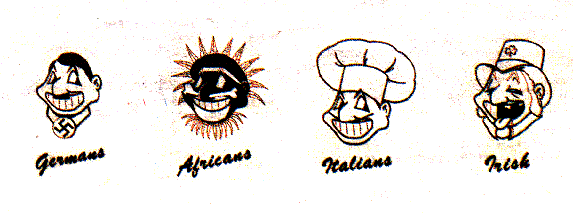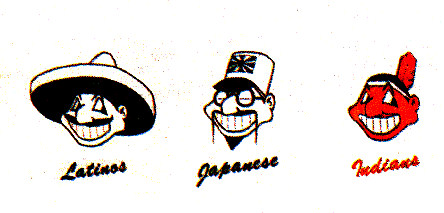Course Handouts and Other Items of Interest | -ISM (N.) Video Documentary Project
Main | Course Syllabus | Supplementary Readings | Learning Analysis Journal
Course Handouts and Other Items of Interest | -ISM (N.) Video Documentary Project
Minneapolis Aztec artist shatters stereotypes
by Mary Abbe / Star Tribune Wherever I look, I see racism
directed at Native Americans," said Oscar Arredondo, a
Minnesota-based artist of Aztec heritage whose show, "A
Mile in My Moccasins," addresses persistent racial
stereotyping in contemporary American culture. The show
features his drawings, sculpture and a huge collage, all
of which throw into stark relief popular culture's
disparaging attitudes about Indians. Without being preachy
or doctrinaire, Arredondo quietly demonstrates the insults
inherent in toys, advertisements and emblems that
incorporate Indian figures and myths. Arredondo has merely collected
and arranged the disparaging material, but the
pervasiveness and diversity of the images, dating from the
1920s to the present, offer overwhelming testimony to the
continued trivialization and stereotyping of Indians
throughout the world. "I have traveled on five
continents and have found it everywhere -- in Australia,
Japan, Sweden, the top of the alps in Switzerland,"
Arredondo said. "I don't mean to be a social activist; I
strive more to be an artist. But until it stops, it has to
be addressed and this is just my contribution to the
cause." A 1987 graduate of the Kansas
City Art Institute, he was born in Washington, D.C., but
lived in many parts of the United States as a child
because his late father worked for NASA as a procurement
officer dealing with radar installations. His father was
one of the last surviving members of an Aztec family that
had, for centuries, resisted Spanish domination of their
Mexican homeland. THORN IN SIDE "We're in the history books
back to 1810 for being a thorn in their side," said
Arredondo, 36, recalling the stories and family legends
told by his father and mother, who was Mexican, English
and Welsh. While that early awareness of history
contributes to his present work, he does not want to be
pigeonholed. "I get really worried about
being labeled a native artist," he said. "My overall goal
is to make a dent in art history. I don't care if I die
with a hole in my bank account, but I do want to make a
dent in art history if I can.' In his assemblage sculpture,
he combines figurines of Indians with bird wings, antlers,
small animal skulls, horns, fur, knives and tomahawks. He
links each piece to Indian history or contemporary
stereotypes. Gilded and bejeweled pinecones in "Death of
Innocence," for example, allude to the European gold lust
that inspired cultural genocide against the Indians. A
shield-like construction encrusted with rusty knives and a
No-Trespassing sign is called "The Scars of Oppression,"
alluding to the defensiveness and hostility some Indians
feel about the dominant culture. A somewhat comical sculpture
titled "My Life as a Bartender" even alludes to
Arredondo's part-time job at First Avenue in downtown
Minneapolis. Designed as an elaborate table lamp, it is a
fur-covered concoction whose base features figurines of
nubile young women -- Indian and white -- standing on a
drum decorated with hearts and animal skulls. On the
lampshade is a note that a woman scrawled onto a napkin
and handed to him at First Avenue. She wrote: "No matter
how we tempt you, breed pure. Keep Native American
Heritage alive." By far the most potent work in
the show is an installation of 17 drawings inspired by
"Chief Wahoo," the bucktoothed mascot of the Cleveland
baseball team. In 16 of the drawings, the maniacally
grinning Wahoo is transformed into a stereotype of another
culture or religion -- the "Catholic" wears a Papal miter;
"White folks" wear a klansman's hood; "Spanish" has a
conquistador's helmet; "African" has a bone in his nose;
"Jew" has owlish glasses and curly hair, and so on.
![]()

The largest piece is a collage about 6 feet tall by 37
feet long composed of Indian-themed advertisements, comic
books, labels, slogans and logos that he has collected. It
includes ads for everything from automobiles and fruit to
baking powder, toys and vacations. In virtually every
item, Indians are reduced to antiquated cliches, the men
depicted as grimacing buckskin-clad warriors in feathered
headdresses and the women as demure maidens decked in
beads and fringe.

The altar-like "Cross of Cortez" incorporates skulls,
guns, baroque cupids and, half-buried in the background,
replicas of the ancient circular calendar of the Aztecs.
Another sculpture combines a tomahawk with the streamlined
Indian head that once served as a hood ornament on
Pontiacs. Called "Day of Reckoning," the piece is meant as
a warning about what might happen if "we lived up to the
stereotypes," Arredondo said.

Like all stereotypes, these are cruel, simplistic,
anachronistic and vulgar. They're insulting enough to get
your dander up. Which is, of course, the point. As
Arredondo points out, none of them would be tolerated in
contemporary America. Except Wahoo himself.
©
Copyright Star Tribune. All rights reserved.
Return to top